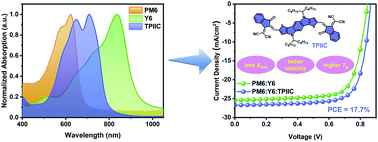High-performance ternary solar cells by introducing a medium bandgap acceptor with complementary absorption, reducing energy disorder and enhancing glass transition temperature†
Abstract
Owing to the relentless march of technology of non-fullerene acceptors (NFAs), ternary organic solar cells (TOSCs) are demonstrating impressive power conversion efficiencies (PCEs). More efficient boosting needs to be achieved in reducing the energy loss (Eloss) and enhancing the operational lifespan of TOSCs. Herein, we introduced a medium bandgap NFA, TPIIC, as the third component into PM6:Y6 host devices and found that the highly crystalline guest acceptor TPIIC with a relatively low lowest unoccupied molecular orbital, is miscible with the Y6 phase. Moreover, compared with the Y6 neat film, the Y6:TPIIC blend films show higher photoluminescence quantum yield, demonstrating the reduced energy disorder in ternary devices. Consequently, ternary devices exhibit reduced non-radiative recombination loss and delivered distinct improvements in the open-circuit voltage (VOC, 0.861 V) and PCE (17.7%) with a reduced Eloss of 0.535 eV, in comparison to the PM6:Y6 host devices (VOC = 0.840 V, PCE = 15.8% and Eloss = 0.547 eV). Importantly, the role of TPIIC in increasing the glass transition temperature of the ternary blend is illustrated and its applicability for improving relevant stability issues of the host devices is verified. Overall, this study developed an effective means to simultaneously reduce the Eloss and improve operation stability of OSCs.



 Please wait while we load your content...
Please wait while we load your content...